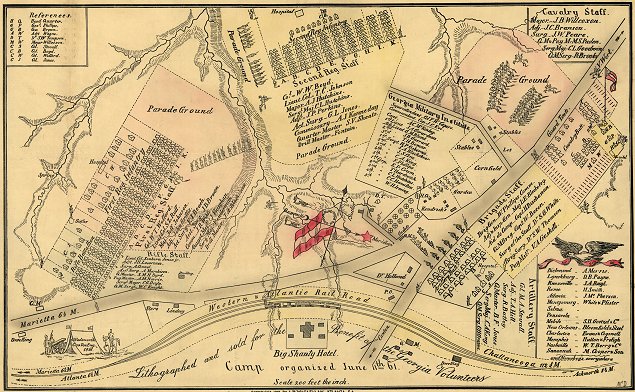
By David Poche
Here is something I didn’t know about the Federal and Confederate armies. Neither army had a Company “J” in their regiments. The letter “J” was replaced by the letter “K” and further research has shown that some regiments even had “L” and “M” Companies. It is also apparent that the order of the Companies in the regimental battle line was anything but alphabetic as I portrayed in Exploring Civil War Campsites.. This unusual arrangement not only affected the order of the companies as they marched and went into battle but also affected their location in campsites. [ Be Aware: many of the figures are taken from large drawings so some figures will load slow....Please be patient ]
Orderly Sargent, Ben Powelson of Company “K” of the 140th Pennsylvania Volunteer Infantry writes in his short history of how the battle line placement of his Company changed through the War. Powelson writes that his Company and Regiment were mustered in September, 1862 and that the initial position of Company “K” in the Regimental battle line was in the middle of the left flank. The battle line of the Regiment consisting of the following companies (A. F. D. I. C. H. E. K. G. B.). Notice there was no Company “J” present. Also notice the order of the Companies in the line seems to be mixed up. Why were the Companies not arranged in alphabetic order (A to K)?
Later Powelson writes that on the 13th of May, 1863 and after several days of fighting in and around Chancellorsville, his Colonel reordered of the Companies of the battle line to (C. B. K. I. A. H. G. D. F. E.). This may have been the result of company causalities or he believed that the new order of the line would present a better fighting unit to the enemy.
On the 19th or 20th of June of
the same year at Centerville, Company
“K”’s positions was changed again. K was now placed near the center of
the line
on the right flank (C.
F. G. D. K. I. B. H. E. A.). It was now part of the Color Guard.
Powelson writes that Company “K” position
in the line never changed after that and the Regiment went on to fight
in many
battles including Gettysburg and Todd’s Tavern.
Records (Fred. P. Todd, Am. Military
Equipage) indicate that the
140th Pennsylvania was initially issued a
mixture of weapons in 1862
– US Model 1842 .69 caliber smoothbore musket and Belgian or “Vincennes
muskets” and .69 Caliber Belgian or French rifled muskets”. The latter
were
probably considered superior weapons when compared to the smoothbores.
AS I
stated in Exploring, usually the superior weapons
were issued to the
best shooters of the regiment and these men were usually placed
together in
Companies “A” and “B”. By 1863 (time of first and second battle line
changes)
the regiment was issued a single weapon: the .58 caliber US Model 1861
rifled
muskets. At this point, it may have not been necessary to distinguish
skirmishers
from the regular enlisted since all of the regiment had the same
weapon. Could
it be that the changes to the battle line were the result of new
weapons issue?
Other regimental histories also suggest the absence of Company “J” and a non-alphabetic battle line and camping/marching formation. The 14th New York Infantry order was (A. C. G. F. E. D. H. K. I. B.). and the formation of the 2nd Michigan infantry was (C. K. H. E. F. I. B. A. G. D.).
Even period drawings and photographs of Federal regimental encampments show the Company “J” absence and the non-alphabetic camping formation of Companies. The single exception to this that I was able to locate was the 1861 drawing of Camp McDonald Georgia , a school of Instruction for the 4th Brigade Georgia Volunteers that is shown below.

Another “T” layout infantry camp is found in the drawing of 196th Regiment of the Ohio Volunteer Infantry made during the Civil War near Stevenson’s Station at Winchester, Virginia. In the Enlisted Area of the camp, ten camp streets (one for each Company) is shown. At the end of each street is a garlanded gateway to the Officers’ Area. Close observation of these gateways (can be seen in the original) show that each garland bears the letter of the Company and the name of the Captain of the Company.
1865
Camp of the 196th Regiment O.V.I. near Stevenson’s Station,
Winchester, Virginia. This Regiment was
issued a single weapon (M1863 rifled musket). [ Click to Explore ] Shown
below
in detail are the Company
letters in Officers' Area and presumably, the Company camping locations and battle line positions
of each
Company (A. F, D. I. C. H. E. K. G. B.). Notice no Company “J” is
present.
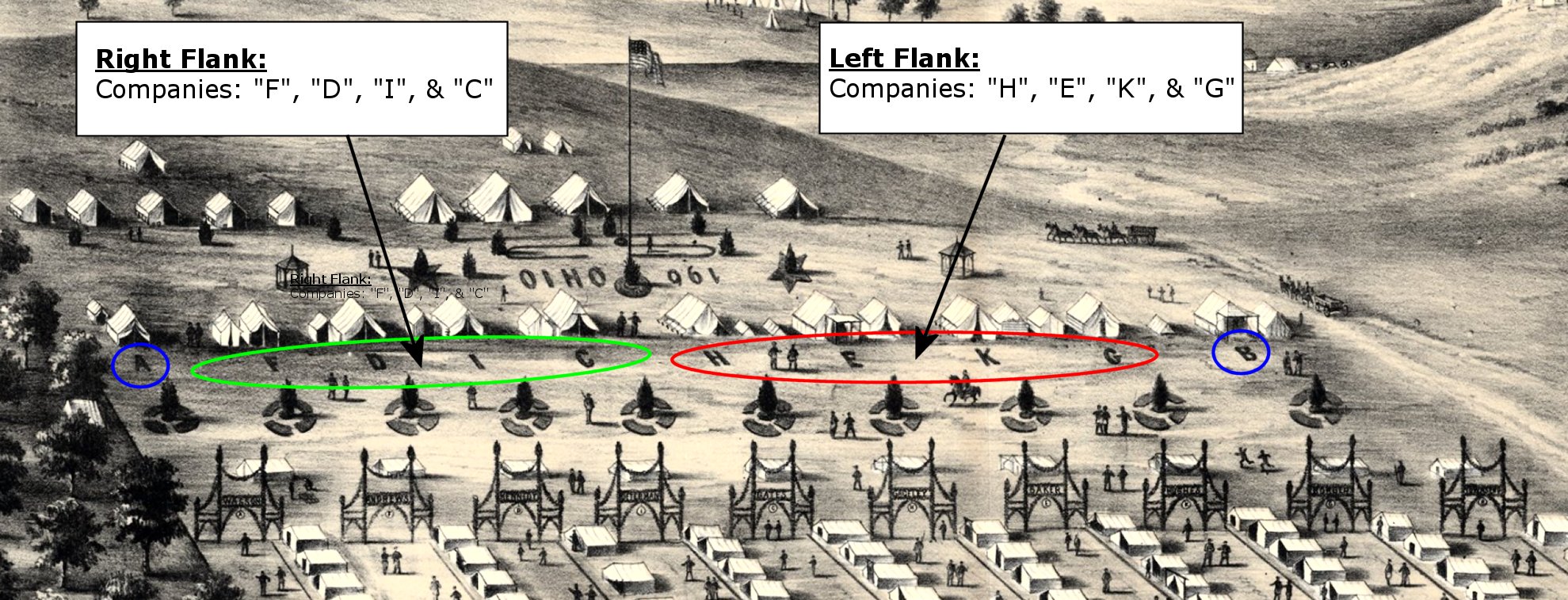
Notice that the Company battle line placement for the 196th O.V.I is identical to the initial positions described for the 140th Pennsylvania Volunteer Infantry.
Another set of garlanded gateway entrances can be seen in the pictures below of the 44th New York Infantry taken at Arlington, Virginia in 1864. Shown below are the ten Company streets of the camp and one main street in the middle leading to the tent of the Colonel.
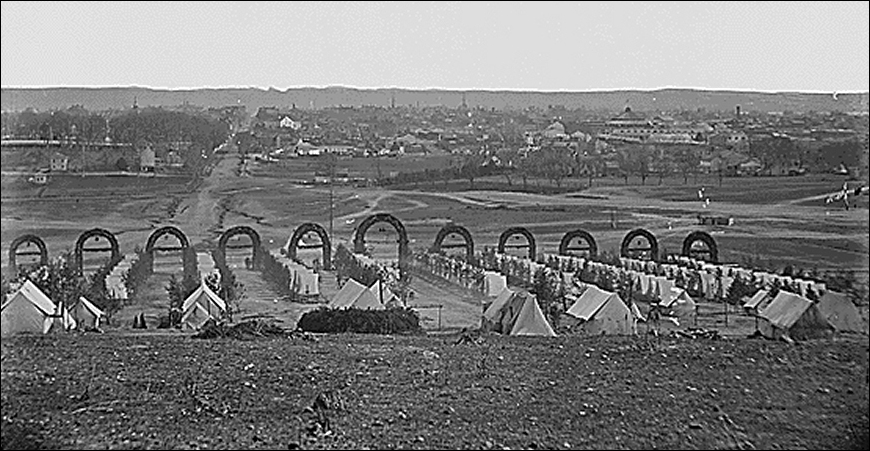
The rear view of the regulation
campsite layout
of the 44th New York Infantry (1864). In
the distance is Alexandria,
Virginia. Mustered in 1861. Below is another picture of the camp of the
front of the camp with
the
regiment on parade. The garlanded gateway entrances to the camp streets
each
have a Company letter suspended from them. The order of the campsite
letters is
also non-alphabetic.

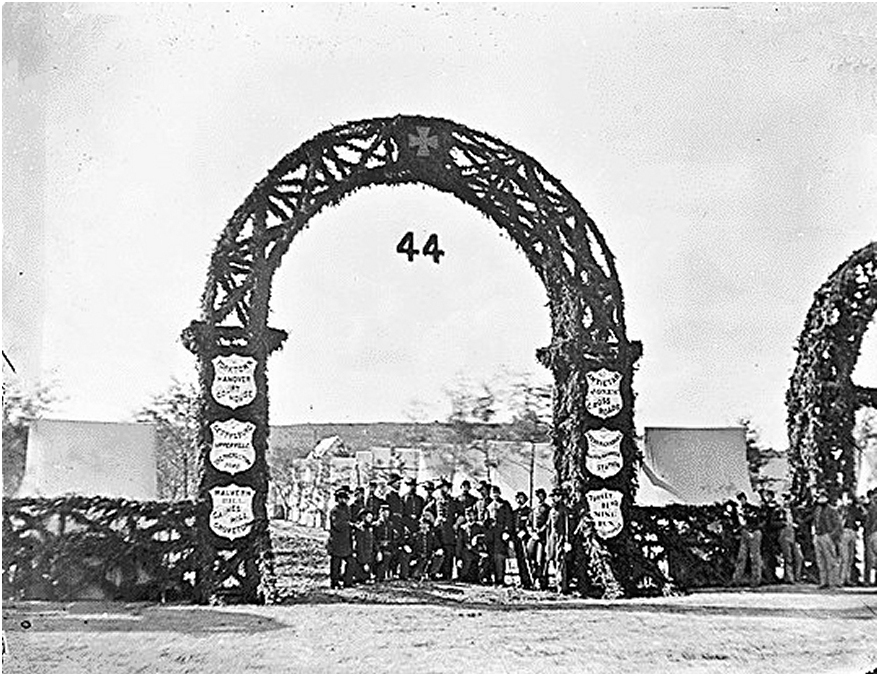
Here is a detail of the main
entrance gateway to the 44th New York Infantry with officers
standing in front. The six shields indicate the principle engagements
that the
regiment had seen by 1864. Note the
Corp designation at the top of the arch. At the time of this picture
regiment
carried Springfield rifled muskets.
The next drawing is of the campsite of the 110th New York Volunteer Infantry at Patterson Park, Md. (1862). The layout is that of a typical infantry camp described in Exploring Civil War Campsites. Company and field officers are segregated from the Enlisted Area of the camp usually by a physical barrier or the Camp flag.
The drawing shows the camping order/marching and battle line order of the Companies to be (A. F. D. I. C. H. E. K. G. B.). This is the same arrangement as the 140th Pennsylvania Volunteers and the 196th O.V.I..
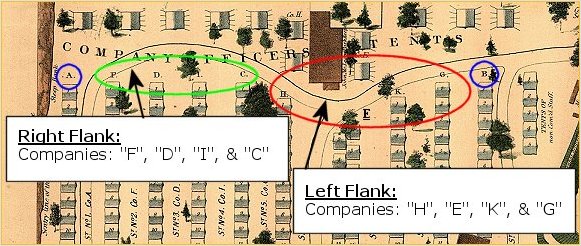
Civil War Camp Chase near Columbus, Ohio. [ Click to Explore ] Shown in detail below are the barracks of 88th O.V.I. Regiment. This Regiment was mustered in 1862 and was issued a mixture of older European weapons. During 1863-1864, the Regiment was issued Springfield rifled muskets.
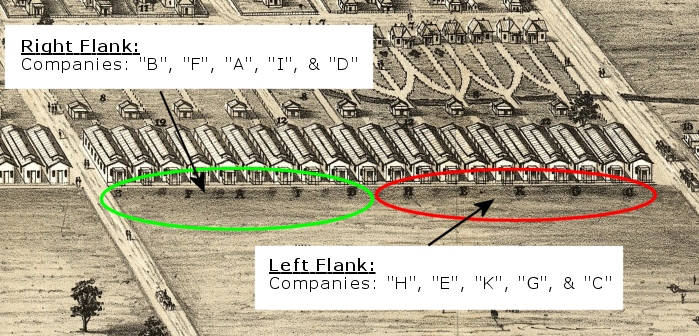
Here are some intriguing possibilities: The answer goes back into history and is probably why there is no “J” street in Washington, DC. In the 18th century English, the capital “I” and “J” were interchangeable especially when hand written. Imagine the confusion trying to deliver a letter to one of two streets next to each other
The 1740 “New General English Dictionary” published in London had a single section for words beginning with I and J. Thomas Jefferson even identified his personal possessions with “T.I.”. This handwriting practice probably continued on into the Civil War period. Those of you who do Civil War genealogy should be aware that veteran “John Issaquah Jones” may show up on company roles as “John J. Jones” or “John I. Jones” or both. It has also been suggested that during the Civil War the pronunciation of “J” could be confused with “A” so “J” was not used .
The origin of “No J” may go back to Roman times. In Latin, "i" and "j" were usually treated as two forms of the same letter. You can see it on this coin shown below: On the back of the coin (right picture below) the word "IVPPITER", appears meaning "Jupiter". The "u" and "v" were also treated as two forms of the same letter. Strange how Rome may have influenced Civil War armies and Washington street names.
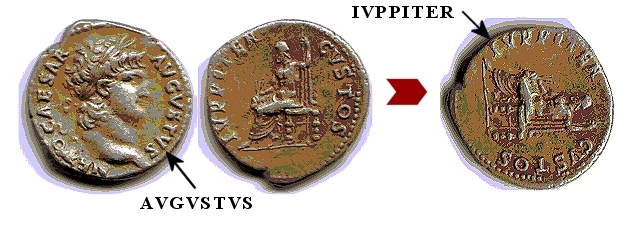
Example Augustus Caesar Roman coin where “i” and “j” were treated as two forms of same letter. Augustus (meaning emperor) was spelled “AVGVSTVS” since “u” and “v” were treated the similar manner. Jupiter was spelled “IVPPITER”.
Joseph Gibbs’ excellent book on the 11th Pennsylvania Reserve Regiment explains well the origins the order of Companies and the functions of the flanking companies. Gibbs states that two flanking companies (in his case “A” and “K” ) were stationed at the two ends of the regimental battle line. According to Gibbs, this was in keeping with General Winfield Scott’s tenets of military thinking who espoused that such companies were to be trained as specialists in the art of skirmishing (Infantry Tactics, Or, Rules for the Exercise and Maneuvre of the United States Infantry (1840)).
According to Scott, skirmishers were to be the advance troops deployed a short distance in front of the remainder of the regiment. These skirmishing companies were trained daily to quickly break ranks and fan out in pairs across an area representing the regiment’s front. Many tactical manuals of the period contained many such skirmishing drills. (William Gilham, 1861 Manual of Instruction for the Volunteers and Militia of the United Stated and W. J Hardee, 1855 & 1862, Rifle and Light Infantry Tactics)
Gibbs further points out that the designation 11th Pennsylvania’s flanking companies of “A” and “K” were at variance with the tactical manuals of their day. Typically most companies were designated alphabetically in order of their captain’s seniority. And most tactical manuals put the skirmishing Companies “A” and “B” on the flanks. Such was not the case for the 11th Pennsylvania. And it might have been easier for raw recruits and inexperienced officers to remember their place in line alphabetically.
Gibbs states that only one 1860 military tactics manual specified the right to left position of Companies in the battle line as (A. F, D. I. C. H. E. K. G. B.). This formation was repeated later in many influential military handbooks including Gilham (1861) and Casey (1862) Infantry Tactics. This appears to account for the Company positioning on many of the examples and differences can be attributed to the prerogatives of the commanding officer of the Regiment, such as, transfers of officers from company staffs to field staffs, and deaths and casualties of officers affecting the seniority of Company commands. Some Regiments probably kept their Company battle line arrangement through the entire War while others changed their arrangements.
Strange as it seems, the lack of non-alphabetic Company lineup may also be a function of changes in basic infantry tactics and an accompanying increase in firepower of issued weapons as the War progressed. Through the War, Commanders learned how to make effective use of flanking cavalry squadrons. There might have been less need for specially trained skirmishers and more need for sharpshooters. Also as better weapons became available there was little need for the best weapons to be issued to the best shots of the Regiment.
All of this research merits a
correction to a figure I placed in Exploring Civil War Campsites. My
original figure had Companies marching into their battle line in
alphabetic
order and below I have corrected to show a more typical formation for
early in
the War. Note that the skirmishing companies are now correctly “A” and
“B” and
there is no Company “J”.
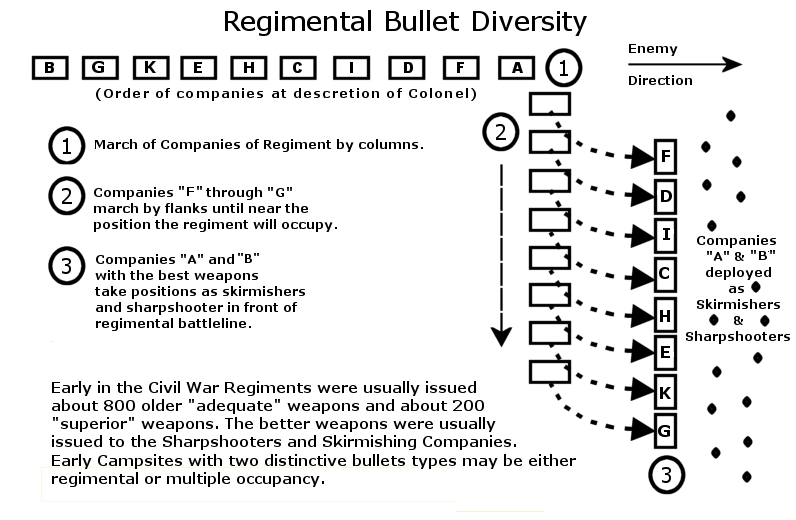
If the relic hunter is able to determine the order of Companies (location kepi letters, etc.) within a campsite location this might help in identification of the camping regiment. Don’t ever buy a kepi letter from Company “J”.
Good Additional Readings:
Ben. F. Powelson, "General History of Company K” at:
http://www.lindapages.com/140pa/140-history.htm
John Toby and Kevin O'Beirne, Editors
“The Columbia Rifles Research Compendium", First and
Second
Editions. Especially see Garr Gast , "The Mechanics of Civil
War
Unit Organization" in the CRRC.
Map Collections of the Library of Congress at:
http://frontiers.loc.gov/ammem/gmdhtml/gmdTitles03.html
Why No “J”
Street in Washington, DC at:
http://www.snopes.com/history/american/jstreet.asp
Joseph Gibbs,
2002, “Three Years in the
Bloody Eleventh: The Campaigns of a Pennsylvania Reserves Regiment , ISBN 978-0-271-02166-9, at Google
Books